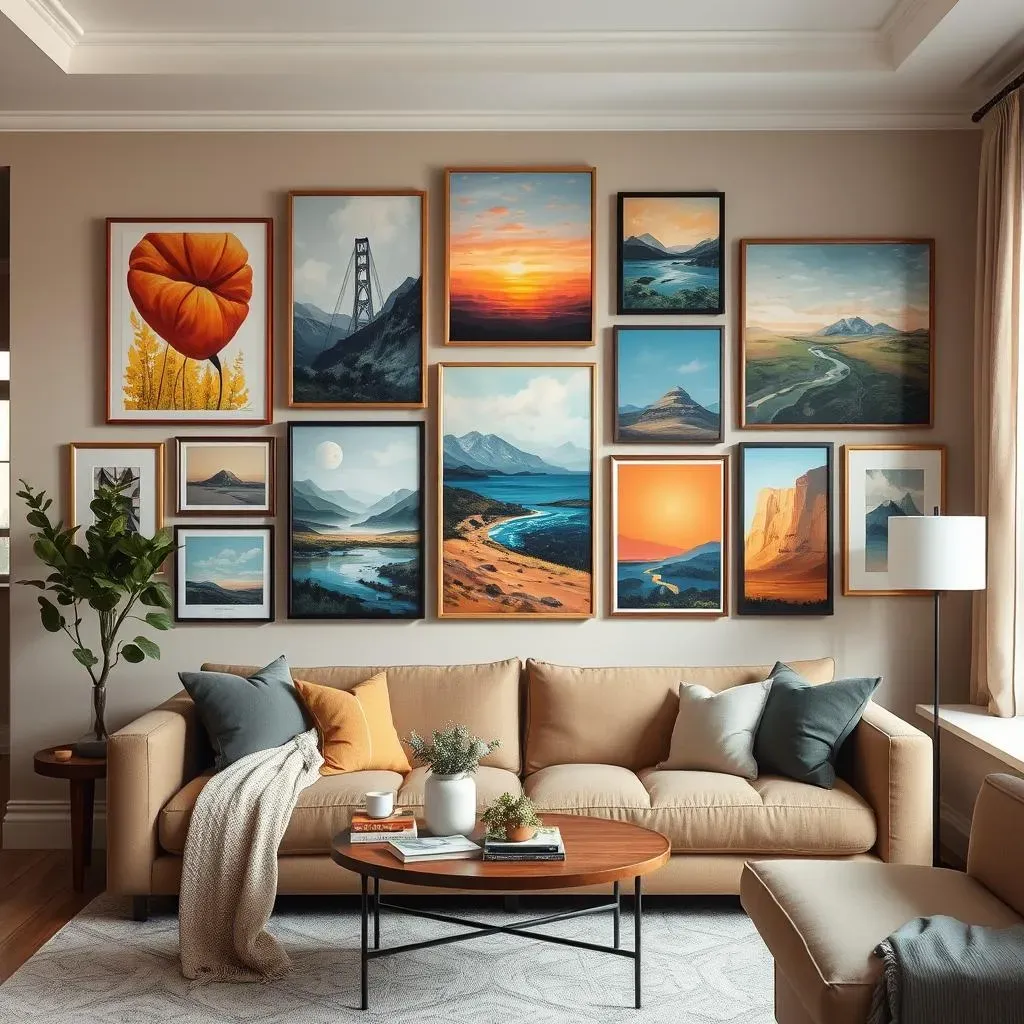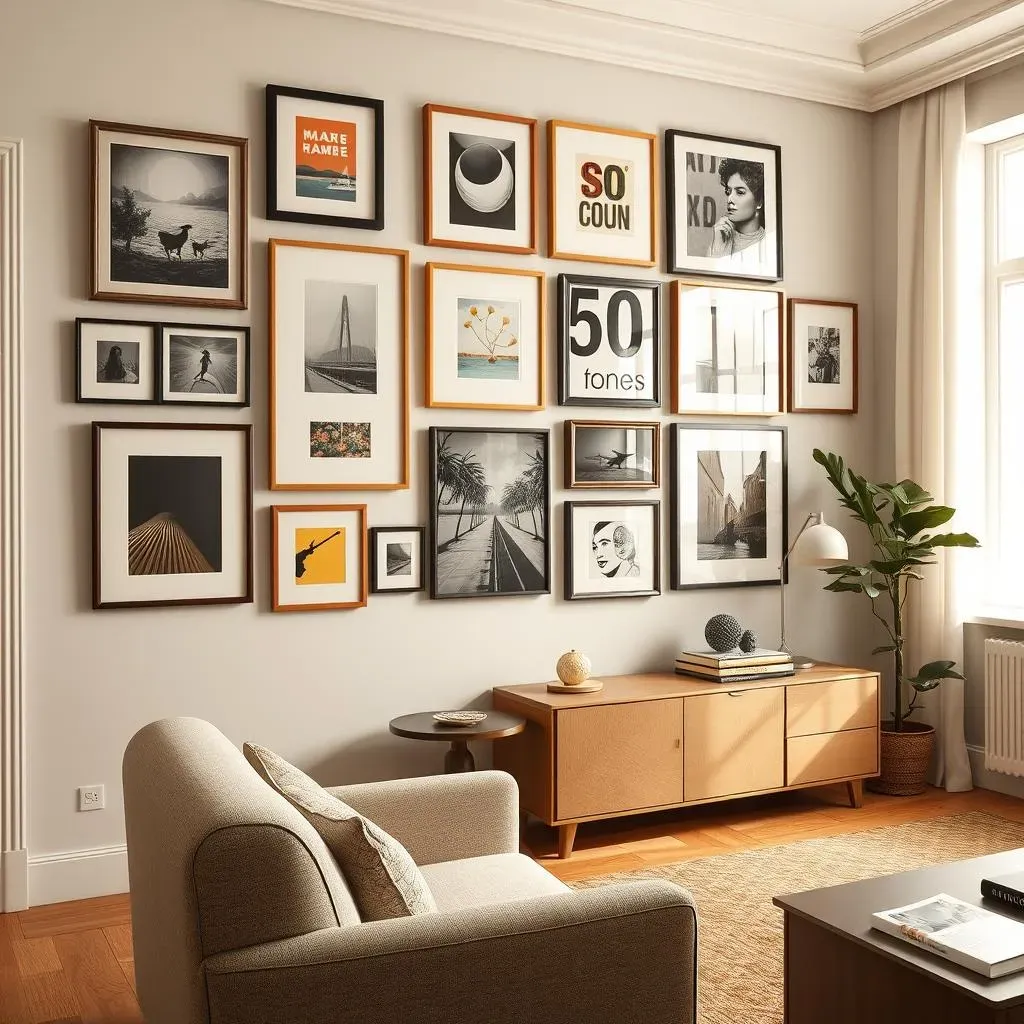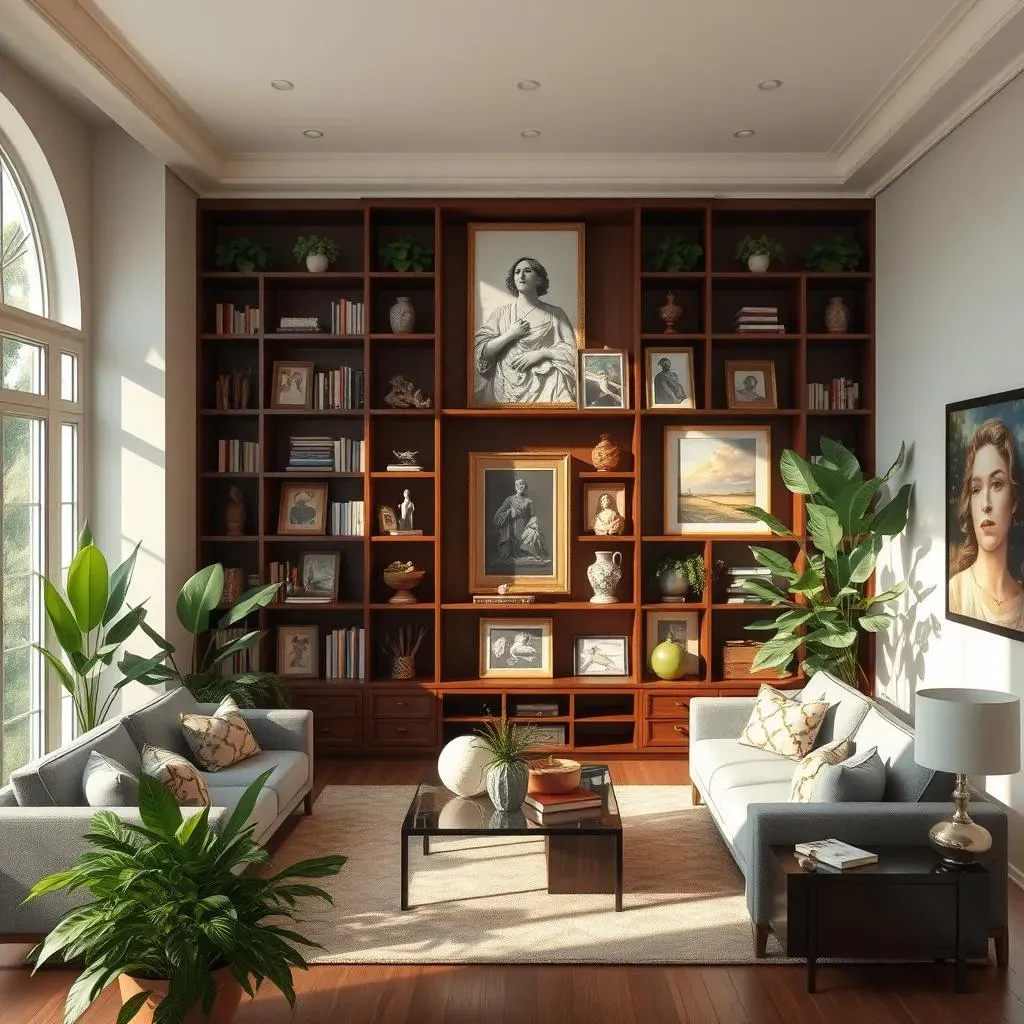Table of Contents
Ever walked into a living room and felt instantly at home? Chances are, the wall art played a big part. It's amazing how a simple picture or print can change the entire vibe of a space, turning a plain room into a personal haven. But finding the perfect piece can feel like a treasure hunt, especially when you're trying to stick to a budget. That's where the magic of "wall art for living room sale" comes in. This article is your map to navigating the world of wall decor, helping you uncover amazing deals without compromising your style. We'll explore different art styles, share tips on finding the best sales, guide you through hanging your new masterpieces, and discuss how to keep your wall art looking fabulous for years to come. So, whether you're a seasoned art collector or just starting to decorate your space, get ready to transform your living room into a reflection of your unique personality without breaking the bank.
Finding the Right Wall Art: A Guide to Styles and Themes
Finding the Right Wall Art: A Guide to Styles and Themes
Navigating the Art World: What Speaks to You?
Okay, so you're ready to dive into the world of wall art, but where do you even start? It's like walking into a massive candy store – so many options, it can be overwhelming! First things first, let's figure out what kind of art makes your heart sing. Are you drawn to vibrant colors and abstract shapes that make you think "wow, that's different?" Or do you prefer the calming scenes of nature, like a peaceful forest or a crashing ocean wave? Maybe you're more into bold graphic prints that add a modern edge to your space. There are no right or wrong answers here; it's all about what resonates with you and your personal style. Think about the overall vibe you're trying to create in your living room. Is it cozy and inviting, sleek and modern, or maybe a bit quirky and eclectic? Your wall art should complement that feeling.
Don't be afraid to mix and match styles, either. Sometimes the most interesting spaces are the ones that break the rules. A classic landscape painting can look fantastic next to a bold, contemporary print. It’s all about creating a visual conversation that reflects your personality. Think of it like putting together an outfit; you wouldn't wear all the same colors and patterns, would you? You’d mix things up to create a look that's unique to you. The same idea applies to your wall art. It’s your chance to show off your creativity and make your living room a place that feels truly like home.
Art Style | Description | Vibe |
|---|---|---|
Abstract | Non-representational art, focusing on shapes, colors, and textures. | Modern, bold, thought-provoking |
Landscape | Depictions of natural scenery, like mountains, forests, or oceans. | Calming, serene, nature-inspired |
Portrait | Images of people, capturing expressions and personalities. | Personal, intimate, engaging |
Graphic | Bold designs with geometric shapes, lines, and patterns. | Modern, edgy, contemporary |
Theme It Up: Cohesion Is Key
Once you've got a handle on your preferred styles, let's talk about themes. A theme is like the glue that holds your wall art together, ensuring it all feels cohesive. It could be as simple as a color palette, like sticking to blues and greens for a calming effect, or it could be a specific subject matter, such as travel, nature, or a particular era. Think about what you love and what makes you feel good. If you're a big fan of vintage maps, why not create a gallery wall featuring maps from different parts of the world? Or, if you're passionate about plants, you could fill your walls with botanical prints. The key is to choose a theme that resonates with you and that you won't get tired of quickly. It's a commitment, like choosing a favorite ice cream flavor, you want to be happy with it every time you see it.
Don't feel like you have to commit to just one theme, either. You can mix and match themes as long as they complement each other. For example, you could combine a nature theme with a travel theme, featuring landscapes from different countries. The idea is to create a visual story that's engaging and personal. When choosing a theme, also consider your existing furniture and decor. You want your wall art to enhance the overall look of your living room, not clash with it. It’s like choosing the perfect frame for a photo; it should complement the image without overpowering it. So, take your time, explore your options, and have fun discovering what speaks to your soul.
“The details are not the details. They make the design.” - Charles Eames
Wall Art for Living Room Sale: Where to Find Amazing Deals
Wall Art for Living Room Sale: Where to Find Amazing Deals
The Hunt Begins: Online Marketplaces
Alright, so you've got your style and theme sorted, now for the fun part: the hunt for bargains! The internet is your best friend here, it's like a giant flea market that never closes. Online marketplaces are goldmines for "wall art for living room sale," offering a huge variety of styles and price points. Think about the big names like Etsy, Amazon, and Wayfair; they're a great place to start, but don't just stop there. Explore smaller online shops; you will often find unique pieces that aren't mass-produced. It's like going to a local craft fair; you might find that one-of-a-kind item that no one else has. Don't be afraid to dig around, use specific search terms, and check out customer reviews. They can give you a good sense of the quality and the seller's reliability. It's like getting a sneak peek before you buy.
Remember to keep an eye out for sales events. Many sites have regular discounts, seasonal promotions, and clearance sections where you can score big deals. Sign up for newsletters from your favorite shops and you'll be the first to know about the latest sales. It’s like having a personal shopping assistant who tells you about all the best bargains. And don’t forget about social media; many artists and small businesses promote their sales through their social media channels. A little bit of digging can really pay off, helping you find that perfect wall art without emptying your wallet. It's all about being smart and savvy in your search.
Marketplace | Pros | Cons |
|---|---|---|
Etsy | Unique, handmade items, supports small businesses | Can be pricier, shipping times may vary |
Amazon | Wide selection, competitive prices, fast shipping | Can be overwhelming, quality may vary |
Wayfair | Variety of styles, often has sales, good for larger pieces | Can be pricier, not always unique designs |
Smaller Online Shops | Unique, often high-quality, supports independent artists | Can be harder to find, less variety |
Offline Gems: Thrift Stores and Local Shops
Don't let online shopping have all the fun; there are still some great places to find "wall art for living room sale" in the real world. Thrift stores are like treasure chests, you never know what you'll find in them. You might stumble upon a vintage painting or a unique print that's perfect for your space and at a fraction of the cost of a brand new piece. It's like going on a real-life scavenger hunt. Local art fairs and craft markets are also great places to find unique and affordable art. You'll be supporting local artists and you'll be able to see the artwork in person before you buy it. It’s like going to a farmer's market, you see the product and get to know the person behind it.
Don't forget about antique shops and flea markets. They're like time machines, taking you back to different eras and styles. You might find a framed print or a piece of vintage art that adds character to your living room. The best part about shopping offline is that you can touch and feel the art before you buy it, and you can often haggle the price a bit. It’s like having a personal connection to the art you choose, and that makes it even more special. So, next time you're out and about, keep your eyes peeled for those offline gems, you might just find the perfect piece for your wall.
"Art washes away from the soul the dust of everyday life." - Pablo Picasso
Hanging and Placement: Tips for Perfect Wall Art Display
Hanging and Placement: Tips for Perfect Wall Art Display
The Art of Arrangement: Finding the Sweet Spot
Okay, you've scored some amazing wall art, now comes the tricky part: hanging it! It’s not just about slapping a picture on the wall and hoping for the best; it's about creating a visual flow that feels balanced and harmonious. First things first, think about eye level. The general rule is to hang your art so that the center of the piece is at about 57-60 inches from the floor. This is considered the average eye level and it ensures that most people will see it comfortably. But, hey, rules are made to be broken, right? If you have high ceilings, you might want to hang your art a bit higher to fill the space, or if you have low furniture, you might want to hang it a bit lower to create a connection between the art and the furniture. It's all about adapting to your specific space. Don't be afraid to experiment and move things around until it feels just right; it's like a puzzle, you need to find the right spot for each piece to make the whole picture look perfect.
When you're hanging multiple pieces, consider creating a gallery wall. It’s like an art exhibition in your own home. You can mix and match sizes, shapes, and frames, but keep a common theme or color palette to tie it all together. Start by laying your pieces out on the floor to experiment with different arrangements before you start hammering nails into the wall. It’s like a dress rehearsal before the big show. You can create a symmetrical look by aligning the centers of the pieces or a more organic look by grouping them in an asymmetrical way. The key is to have fun with it and let your creativity shine. Don't be afraid to try something new; art is all about expression, and your wall art display is a reflection of your unique style.
Arrangement Style | Description | Best For |
|---|---|---|
Symmetrical | Art pieces are hung in a balanced, mirrored arrangement. | Formal spaces, creating a sense of order |
Asymmetrical | Art pieces are hung in a less structured, more organic way. | Relaxed spaces, creating a sense of movement |
Grid | Art pieces are hung in a precise, grid-like pattern. | Modern spaces, creating a clean, organized look |
Salon Style | Art pieces of various sizes and shapes are clustered together. | Eclectic spaces, creating a bold, personal statement |
Tools and Techniques: Hanging Like a Pro
Alright, let's talk about the nitty-gritty of actually getting those pieces on the wall. You don't need to be a professional handyman to hang art like a pro; you just need the right tools and a little bit of patience. Start with the basics: a level, a measuring tape, a pencil, and a hammer. A level is crucial for making sure your art is hanging straight. It's like making sure your cake is level before you put on the frosting. A measuring tape will help you determine the correct spacing, and a pencil will allow you to mark the spot where you want to hang your art. If you're hanging heavier pieces, you might want to use picture-hanging hooks or anchors to make sure they're securely attached to the wall. It's like using the right kind of screws for a big project; you want to make sure everything is stable and secure.
When you're hammering in the nails, be gentle and precise. Don't go all Hulk on the wall; take your time and make sure the nail is going in straight. If you're hanging multiple pieces, use your measuring tape to ensure that they're evenly spaced. It’s like laying out a tile floor; you want everything to line up perfectly. And if you're feeling a bit unsure, there are plenty of tutorials online that can walk you through the process step by step. It's like having a personal tutor guiding you through each step. So, don't be intimidated by the hanging process; with a little bit of preparation and the right tools, you can create a stunning wall art display that you'll be proud of.
"Have nothing in your house that you do not know to be useful, or believe to be beautiful." - William Morris
Maintaining and Choosing Wall Art: LongTerm Care and Options
Maintaining and Choosing Wall Art: LongTerm Care and Options
Keeping It Fresh: Long-Term Care Tips
So, you've finally got your wall art up, and it looks amazing. Now, let's talk about keeping it that way. Just like anything you love, your wall art needs a little TLC to stay in top condition. First off, think about the environment. Direct sunlight is like a kryptonite for art, it can cause colors to fade and materials to degrade over time. It’s like leaving your favorite t-shirt out in the sun all day; it’ll get bleached and worn. Try to avoid placing your art in areas that get a lot of direct sunlight or consider using UV-protective glass if you're hanging something valuable. Also, think about humidity levels. Too much moisture can damage your artwork, especially paper-based pieces. It’s like leaving a book in the bathroom while you shower, it'll get all warped and soggy. Keep your art in a place where humidity levels are relatively stable. It’s all about creating a comfortable environment for your art to live in.
Regular cleaning is also key, but don't go crazy with the cleaning products. A gentle dusting with a soft cloth is usually all you need to keep your art looking fresh. Avoid using harsh chemicals or abrasive cleaners; they can damage the artwork. It's like washing a delicate sweater; you need to be gentle. If you're not sure how to clean a particular piece, it's always best to consult a professional. It’s like taking your car to a mechanic if you don't know what's wrong with it; they've got the expertise to handle it. And remember, prevention is always better than cure. So, keeping your art away from direct sunlight and humidity will go a long way in preserving it for years to come. It's like taking care of a garden; a little bit of effort can make it thrive.
Care Tip | Description | Why It's Important |
|---|---|---|
Avoid Direct Sunlight | Place art away from direct sunlight. | Prevents fading and damage. |
Control Humidity | Keep art in a stable humidity environment. | Prevents warping and mold. |
Gentle Dusting | Regularly dust with a soft cloth. | Removes dust and keeps art looking fresh. |
Professional Cleaning | Consult a professional for delicate pieces. | Ensures proper cleaning without damage. |
Making Smart Choices: What to Consider Before Buying
Now, let's talk about making smart choices when it comes to buying new wall art. It's not just about finding something that looks pretty; it's about choosing pieces that will last and that you'll love for a long time. Think about the quality of the materials. Is the print on high-quality paper or canvas? Is the frame sturdy and well-made? It's like buying a good pair of shoes; you want them to be durable and comfortable. Don't be afraid to ask questions about the materials and the process used to create the art. It’s like getting the ingredients list for a recipe; you want to know what you're putting in your body and on your walls. Consider your lifestyle as well. If you have kids or pets, you might want to avoid delicate pieces that are easily damaged. It's like choosing furniture that can withstand a bit of wear and tear. Choose art that's not only beautiful but also practical for your situation. It’s about making smart choices that fit your lifestyle.
And don't forget to think about your future plans. Will you be moving soon? Will you be redecorating your living room in a few years? Choose art that you can easily move or that will fit into different design schemes. It's like buying clothes that you can mix and match with different outfits; you want them to be versatile. And finally, don't just buy art because it's on sale. Buy art because you love it. It's like choosing a friend; you want someone who you connect with and who makes you feel good. Your wall art should be a reflection of your personality and your values, not just a collection of pretty things. So, take your time, do your research, and choose pieces that will bring you joy for years to come. It’s about making choices that add value to your life.
“Every artist dips his brush in his own soul, and paints his own nature into his pictures.” - Henry Ward Beecher